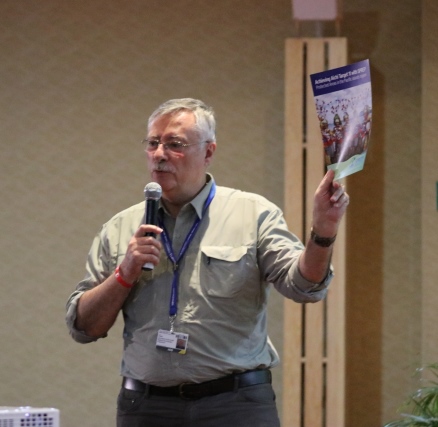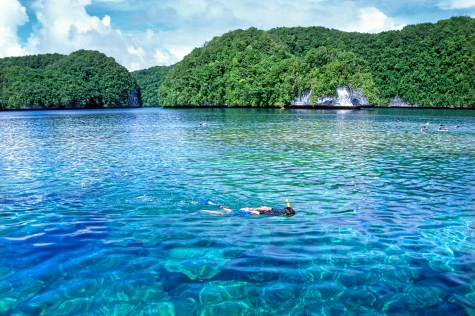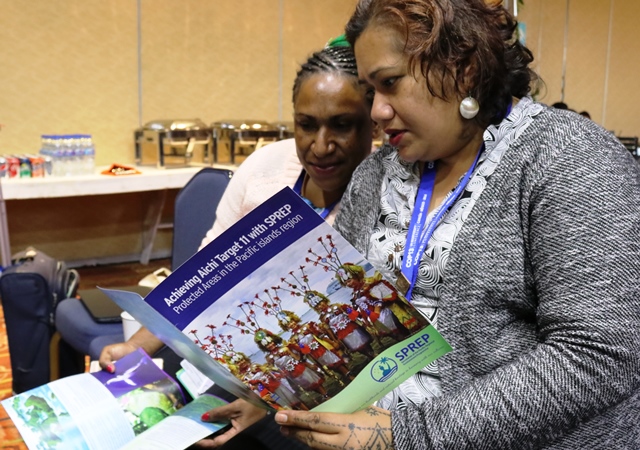
Biodiversity Conservation
"Investing in the conservation of biodiversity and ecosystems is one of the most effective, efficient and equitable pathways to achieving the sustainable development goals," – Helen Clark, Director General, UNDP
13 December 2016, CBD COP13, Cancun Mexico – "Partnerships for improving natural wealth for achieving global targets and for addressing global challenges" was the theme of the Protected Areas day at the Rio Pavilion, Thirteenth Conference of the Parties to the Convention on Biological Diversity (CBD COP13) in Cancun, Mexico.
The forum discussed the status of implementation of Aichi Target 11 which protects 17% of terrestrial and 10% of marine areas, and national "roadmaps" of priority actions; how the roadmaps contribute to achieving the Target; and helping countries in implementing their roadmap in order to achieve multiple benefits.

Mr Stuart Chape, Director of the Biodiversity and Ecosystem Services Division of the Secretariat of the Pacific Regional Environment Programme (SPREP), gave a presentation on how SPREP supports its member countries to achieve Target 11. The Pacific island region has one of the highest rates of species extinction across the world, being home to over 800 species with a high probability of extinction, and our native forest cover is being lost at up to 4% per annum, with less than 30% of our forest remaining in a natural state.
"The value of our Pacific biodiversity and ecosystems are extremely high, and the ecosystem services that they provide are irreplaceable," said Mr Chape.
"For example, our oceans provide for national economic development by providing hundreds of millions of dollars to Pacific countries from the shared regional resource of the largest tuna fishery in the world, and critical food security and income for local communities from coastal fisheries."
"Sustainability of this valuable resource depends on maintaining the ecological health of oceans and coasts. Similarly, Pacific countries receive millions of dollars of income from tourism that is dependent on high quality ecosystems."
While considerable progress has been made to protect and conserve the environment, challenges continue to grow.
Pollution and waste management, invasive species, increasing urbanisation, El Nino events, and the increasing impacts of climate change, such as ocean acidification, sea level rise, and changing rainfall patterns and weather events threaten the integrity of natural ecosystems and place increasing demands on the services they provide to Pacific people.
Protected areas play a vital role in ensuring that ecosystems can continue to provide essential services, and protecting the natural heritage of the Pacific islands.

Marine Protected Area Chelbacheb, Palau. Photo by Stuart Chape
In Palau, the Protected Areas Network (PAN) created through legislation, is conserving both marine and terrestrial biodiversity and ecosystems throughout the country. The PAN is funded by the Green Fund, which is an added environment tax of USD 30 to be paid upon departure of Palau, which then contributes towards strengthening the Protected Areas of Palau. PAN membership means eligibility for national funding from the Green Fund, allows for access to technical resources as well as participating in a national monitoring system.
Right now, there are about 34 discrete sites that are part of 15 systems of Protected Areas under the PAN as well as Palau's Rock Islands Southern Lagoon as a UNESCO World Heritage Site.
"I think our Protected Areas are one of the most important tools we have for conserving our biodiversity. Our Government has a whole system dedicated to this in the Protected Areas Network," said Ms Gwen Sisior, Senior projects manager, Ministry of Natural Resources, Environment & Tourism, Palau.
"Palauan communities were sold on the concept of Protected Areas on the social benefits resulting from set asides. Increased fish and clean water are just some of the benefits that drove the creation of protected marine and terrestrial areas. Because protected areas are a logical progression from our traditional resource management systems they were readily accepted in our communities."
According to UNDP, protected areas play a major role in enhancing local and national food security with fisheries sustaining the livelihoods of over 925 million people, one out of eight people on Earth depend directly on tropical forests for their food needs.
Protected areas also play a major role in ensuring local and national water security. Forest protected areas supply a third of the world's largest cities with drinking water and 75% of agriculture worldwide depends on forested watersheds and wetlands.
"I think Protected Areas are extremely important for the Pacific islanders, they are crucial for our livelihoods," said Ms Elizabeth Munro of the Cook Islands National Environment Service.
Takuvaine village on Rarotonga has a management plan in place for the protection of its watershed; and the Cook Islands government has launched the Marae Moana Marine Park placing their full EEZ under conservation; several of the islands within the 15 islands of the Cook Islands are whole protected areas and there are traditionally managed areas called rau'i both on Rarotonga and in the outer islands.
"We have also found that if you talk about biodiversity, our communities in the Cook Islands still don't understand the term, however if you talk about our environment, then yes they know that and they know the value of their environment and want to protect it."

The Pacific islands have put in place the framework and structure with support from SPREP and other partners. The 'Framework for Nature Conservation and Protected Areas in the Pacific Islands Region 2014 – 2020' was adopted by the 9th Pacific Islands Nature Conservation and Protected Conference in 2013. Participants at the conference agreed that the framework should be linked closely with the Convention on Biological Diversity Aichi Targets in order to focus on Pacific country priorities.
There is also a Pacific islands Protected Areas Portal (pipap.sprep.org) which is a 'one-stop-shop' online portal for all information pertaining to protected areas in the region. Embedded within the PIPAP is a BIOPAMA-supported Regional Reference Information System (RRIS), the online data and information platform that brings together relevant information to support decision-making for planning, designating and managing protected-managed areas in the Pacific region.
Achieving the Aichi Targets, including Target 11, has a number of challenges.
"Across the region we face resources constraints, in terms of human capacity, financial resources and technical support, external funding availability is often opportunistic and short term and there is the complexity of traditional land and resource ownership," said Mr Chape.
"Even so, Pacific island countries and communities have made enormous commitments to protect the environment, and collectively Pacific countries have almost achieved the 10% target for marine conservation. However, achieving the 17% target for terrestrial protection still requires much more commitment."
Aichi Target 11 commits Pacific island parties to the Convention on Biological Diversity to ensure that by 2020, at least 17 per cent of terrestrial and inland water, and 10 per cent of coastal and marine areas, especially areas of particular importance for biodiversity and ecosystem services, are conserved through effectively and equitably managed, ecologically representative and well-connected systems of protected areas and other effective area-based conservation measures, and integrated into the wider landscapes and seascapes.
The Pacific islands region, including the Hawaiian islands, has now overall achieved Aichi Target 11, ensuring that by 2020 at least 10 per cent of coastal and marine areas are conserved, with some SPREP members having developed country roadmaps to help them achieve this goal.
Pacific island parties to the CBD are the Cook Islands, Federated States of Micronesia, Fiji, Kiribati, Marshall Islands, Nauru, Niue, Palau, PNG, Samoa, Solomon Islands, Tuvalu, Tonga and Vanuatu. Protected Areas Day at the Rio Conventions Pavilion at the CBD COP13 was on Monday, 12 December, 2016 - #PacificProtectedAreas
The CBD COP13 is held in Cancun, Mexico from 4 – 17 December, 2016. To learn more about this please visit: http://cop13.mx/en/
13 December 2016, CBD COP13, Cancun Mexico – "Partnerships for improving natural wealth for achieving global targets and for addressing global challenges" was the theme of the Protected Areas day at the Rio Pavilion, Thirteenth Conference of the Parties to the Convention on Biological Diversity (CBD COP13) in Cancun, Mexico.
The forum discussed the status of implementation of Aichi Target 11 which protects 17% of terrestrial and 10% of marine areas, and national "roadmaps" of priority actions; how the roadmaps contribute to achieving the Target; and helping countries in implementing their roadmap in order to achieve multiple benefits.

Mr Stuart Chape, Director of the Biodiversity and Ecosystem Services Division of the Secretariat of the Pacific Regional Environment Programme (SPREP), gave a presentation on how SPREP supports its member countries to achieve Target 11. The Pacific island region has one of the highest rates of species extinction across the world, being home to over 800 species with a high probability of extinction, and our native forest cover is being lost at up to 4% per annum, with less than 30% of our forest remaining in a natural state.
"The value of our Pacific biodiversity and ecosystems are extremely high, and the ecosystem services that they provide are irreplaceable," said Mr Chape.
"For example, our oceans provide for national economic development by providing hundreds of millions of dollars to Pacific countries from the shared regional resource of the largest tuna fishery in the world, and critical food security and income for local communities from coastal fisheries."
"Sustainability of this valuable resource depends on maintaining the ecological health of oceans and coasts. Similarly, Pacific countries receive millions of dollars of income from tourism that is dependent on high quality ecosystems."
While considerable progress has been made to protect and conserve the environment, challenges continue to grow.
Pollution and waste management, invasive species, increasing urbanisation, El Nino events, and the increasing impacts of climate change, such as ocean acidification, sea level rise, and changing rainfall patterns and weather events threaten the integrity of natural ecosystems and place increasing demands on the services they provide to Pacific people.
Protected areas play a vital role in ensuring that ecosystems can continue to provide essential services, and protecting the natural heritage of the Pacific islands.

Marine Protected Area Chelbacheb, Palau. Photo by Stuart Chape
In Palau, the Protected Areas Network (PAN) created through legislation, is conserving both marine and terrestrial biodiversity and ecosystems throughout the country. The PAN is funded by the Green Fund, which is an added environment tax of USD 30 to be paid upon departure of Palau, which then contributes towards strengthening the Protected Areas of Palau. PAN membership means eligibility for national funding from the Green Fund, allows for access to technical resources as well as participating in a national monitoring system.
Right now, there are about 34 discrete sites that are part of 15 systems of Protected Areas under the PAN as well as Palau's Rock Islands Southern Lagoon as a UNESCO World Heritage Site.
"I think our Protected Areas are one of the most important tools we have for conserving our biodiversity. Our Government has a whole system dedicated to this in the Protected Areas Network," said Ms Gwen Sisior, Senior projects manager, Ministry of Natural Resources, Environment & Tourism, Palau.
"Palauan communities were sold on the concept of Protected Areas on the social benefits resulting from set asides. Increased fish and clean water are just some of the benefits that drove the creation of protected marine and terrestrial areas. Because protected areas are a logical progression from our traditional resource management systems they were readily accepted in our communities."
According to UNDP, protected areas play a major role in enhancing local and national food security with fisheries sustaining the livelihoods of over 925 million people, one out of eight people on Earth depend directly on tropical forests for their food needs.
Protected areas also play a major role in ensuring local and national water security. Forest protected areas supply a third of the world's largest cities with drinking water and 75% of agriculture worldwide depends on forested watersheds and wetlands.
"I think Protected Areas are extremely important for the Pacific islanders, they are crucial for our livelihoods," said Ms Elizabeth Munro of the Cook Islands National Environment Service.
Takuvaine village on Rarotonga has a management plan in place for the protection of its watershed; and the Cook Islands government has launched the Marae Moana Marine Park placing their full EEZ under conservation; several of the islands within the 15 islands of the Cook Islands are whole protected areas and there are traditionally managed areas called rau'i both on Rarotonga and in the outer islands.
"We have also found that if you talk about biodiversity, our communities in the Cook Islands still don't understand the term, however if you talk about our environment, then yes they know that and they know the value of their environment and want to protect it."

The Pacific islands have put in place the framework and structure with support from SPREP and other partners. The 'Framework for Nature Conservation and Protected Areas in the Pacific Islands Region 2014 – 2020' was adopted by the 9th Pacific Islands Nature Conservation and Protected Conference in 2013. Participants at the conference agreed that the framework should be linked closely with the Convention on Biological Diversity Aichi Targets in order to focus on Pacific country priorities.
There is also a Pacific islands Protected Areas Portal (pipap.sprep.org) which is a 'one-stop-shop' online portal for all information pertaining to protected areas in the region. Embedded within the PIPAP is a BIOPAMA-supported Regional Reference Information System (RRIS), the online data and information platform that brings together relevant information to support decision-making for planning, designating and managing protected-managed areas in the Pacific region.
Achieving the Aichi Targets, including Target 11, has a number of challenges.
"Across the region we face resources constraints, in terms of human capacity, financial resources and technical support, external funding availability is often opportunistic and short term and there is the complexity of traditional land and resource ownership," said Mr Chape.
"Even so, Pacific island countries and communities have made enormous commitments to protect the environment, and collectively Pacific countries have almost achieved the 10% target for marine conservation. However, achieving the 17% target for terrestrial protection still requires much more commitment."
Aichi Target 11 commits Pacific island parties to the Convention on Biological Diversity to ensure that by 2020, at least 17 per cent of terrestrial and inland water, and 10 per cent of coastal and marine areas, especially areas of particular importance for biodiversity and ecosystem services, are conserved through effectively and equitably managed, ecologically representative and well-connected systems of protected areas and other effective area-based conservation measures, and integrated into the wider landscapes and seascapes.
The Pacific islands region, including the Hawaiian islands, has now overall achieved Aichi Target 11, ensuring that by 2020 at least 10 per cent of coastal and marine areas are conserved, with some SPREP members having developed country roadmaps to help them achieve this goal.
Pacific island parties to the CBD are the Cook Islands, Federated States of Micronesia, Fiji, Kiribati, Marshall Islands, Nauru, Niue, Palau, PNG, Samoa, Solomon Islands, Tuvalu, Tonga and Vanuatu. Protected Areas Day at the Rio Conventions Pavilion at the CBD COP13 was on Monday, 12 December, 2016 - #PacificProtectedAreas
The CBD COP13 is held in Cancun, Mexico from 4 – 17 December, 2016. To learn more about this please visit: http://cop13.mx/en/